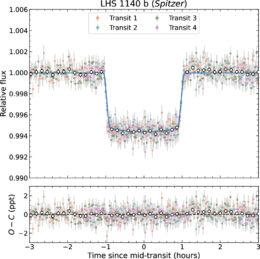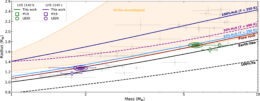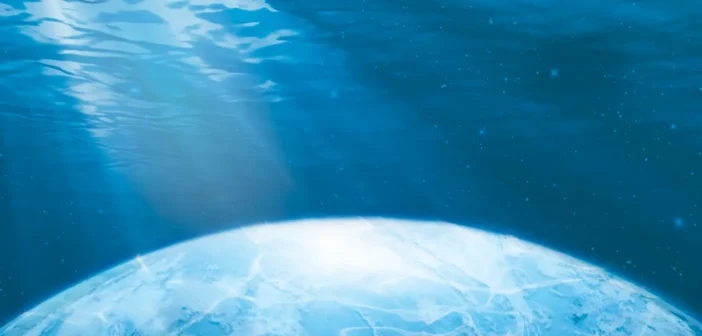One would be forgiven for thinking that it’s easy to tell different types of planets apart. Unfortunately, the most interesting worlds look awfully like comparatively boring ones to our telescopes. A well-studied planet, LHS 1140 b, nicely illustrates this tension: after a re-analysis of archival data, it’s unclear if the planet has a potentially habitable surface ocean, or just a thin layer of hydrogen over a rocky surface.
Previous Work

Observations of four transits of LHS 1140 b collected by the Spitzer Space Telescope. [Cadieux et al. 2024]
Consequently, LHS 1140 has been observed with a battery of instruments since the discovery of its two accompanying planets in 2017 and 2019. When analyzed one-by-one these datasets suggest that the two worlds, creatively christened in the typical exoplanet fashion as LHS 1140 b and LHS 1140 c, are a little bigger and heavier than our home world but basically made of the same combination of rock and metal. However, all of these observations hadn’t before been analyzed in a single, joint study.
Another Look
Charles Cadieux, University of Montreal, took up this challenge and led a team to reprocess nearly every byte of information collected on these worlds in an attempt to better constrain their masses and radii. They succeeded: as the authors put it, “the LHS 1140 planets are [now] among the best-characterized exoplanets to date, with relative uncertainties of only 3% for the mass and 2% for the radius.”
However, the team wasn’t aiming to shrink the old error bars just for precision’s sake. Instead, their ultimate aim was to constrain the composition of each planet. Although their analysis confirmed that LHS 1140 c is likely a generic super-Earth, their new measurements placed LHS 1140 b in a strange corner of parameter space.

The mass and radius of the LHS 1140 planets, along with contours belonging to different compositions. LHS 1140 b falls just above the rocky line, but on the very edge of the gas-envelope region. Click to enlarge. [Cadieux et al. 2024]
A Path Forwards
While it’d be thrilling to have a potentially habitable planet in our galactic backyard, our current data, even when collected with our best instruments and processed with the most cutting-edge techniques, is frustratingly unable to distinguish between the two scenarios. There is technically a path forward to resolving the uncertainty: the authors boldly advocate for an 18-transit observational campaign with JWST to confirm a thick, water-friendly atmosphere. However, with many planets to point to and galaxies galore to observe, there’s no guarantee that the community will choose to dedicate so much time to one target. We may have to live with just the hint that there’s a nearby alien ocean: a bitter, but awe-inspiring, ambiguity.
Citation
“New Mass and Radius Constraints on the LHS 1140 Planets: LHS 1140 b Is either a Temperate Mini-Neptune or a Water World,” Charles Cadieux et al 2024 ApJL 960 L3. doi:10.3847/2041-8213/ad1691

